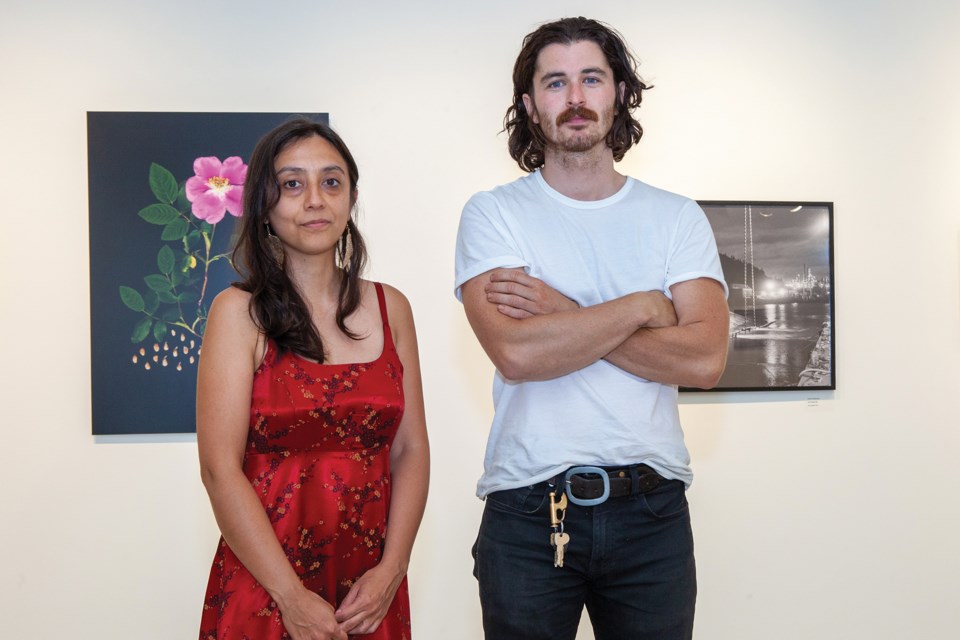Photography that features nature’s fluidity — on dramatically different scales — is the focus of the Gibsons Public Art Gallery’s latest show, which opened on July 28.
Artists Reave Dennison and Laara Cerman visited the gallery on July 30 to introduce their respective exhibitions during a public reception.
Dennison is a photographer whose series of black-and-white silver gelatin prints compose Under 60 Tons. Dennison was raised in Gibsons and graduated from Elphinstone Secondary School. He now pairs his photography with work as a mate on the type of working vessels featured in his images.
Dennison’s images are shot from a mariner’s perspective and developed by hand at his Mayne Island studio. He eschews placid harbours in favour of choppy seas, rust-lined bulkheads, and rain-streaked glass. In Barge Swap, he captures the industrial intimacy of a tug being tethered to its load, beams from sailors’ headlamps flaring in the dusk. Brawny cables embrace a bird’s nest with five unhatched eggs in Bowline. A weary skipper presses fingers to his temple in the ominously-titled Jonah.
“I think I’ve always kind of been attracted to that sort of gritty, rough lifestyle,” Dennison said. “There’s a certain mystique that I found needed to be exposed in this particular project. [Barging and towage] goes on constantly throughout the entire year, and people don’t really see it. It takes a lot for the people who work out there to have a bad day. Everything is relative on the West Coast.”
Dennison is occasionally distracted from a prospective photograph by the need to fulfill his nautical responsibilities. Recollecting stormy days at sea, he said, “There’s a lot that’s lost because I have to put the job first. And I’ve seen quite a lot of things where you couldn’t photograph them because they were too intense.”
After developing a technique to illuminate settings with flashlights and long exposures, Dennison is now experimenting with underwater photography. “The sea is so real,” he said. “There are little things here and there that humans contribute to it, but it’s always right.”
The tenacity of nature is also the subject of Laara Cerman’s botanical studies in Codex Pacificus. After working with a photographer who stitched together portraits into large-scale composites, she applied the same principle to the creation of high-resolution plant imagery. “Since 2016, I’ve been scanning specimens,” she said, “and it’s been a really good excuse to just travel around and see what’s growing.”
Cerman, a native of New Westminster, studied at Vancouver College of Art and Design and Langara College. Her chromogenic prints depict bright-hued specimens like red-osier dogwood and salmonberry in razor-sharp contrast against black backgrounds. Each plant can require up to three scans before being composited alongside other features like blossoms and seedpods. “I think I’m aiming for about 60 per cent beauty and 40 per cent accuracy,” she said.
Cerman’s subjects include introduced species like creeping buttercup and brown knapweed. “The invasive plants are not going to go away,” she said, “but I think we just need to learn how to manage them and still make space for native plants. Kind of like people: you have invasive people, and we still we have to accommodate them somehow.”
A three-dimensional installation titled Flora’s Song germinated from Cerman’s conversation with geneticist Dr. Scott Pownall in 2019. The two devised a mechanism to transpose the sequence of DNA nucleotides in plant species into musical notes. Cerman fashioned a hand-cranked music box that plays the tune.
“I was hoping for it to be some kind of melody,” she said. “And I think at first when you play it, it sounds very random, but the more you play it, you do start to hear sections that have an audible pattern.”
Under Six Tons and Codex Pacificus remain on display at the Gibsons Public Art Gallery until Aug. 21.



